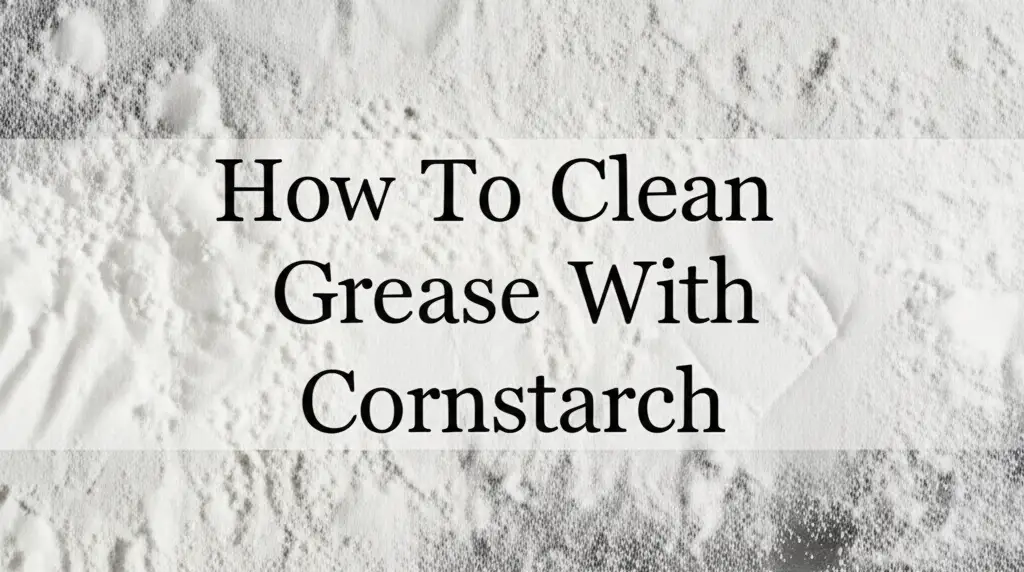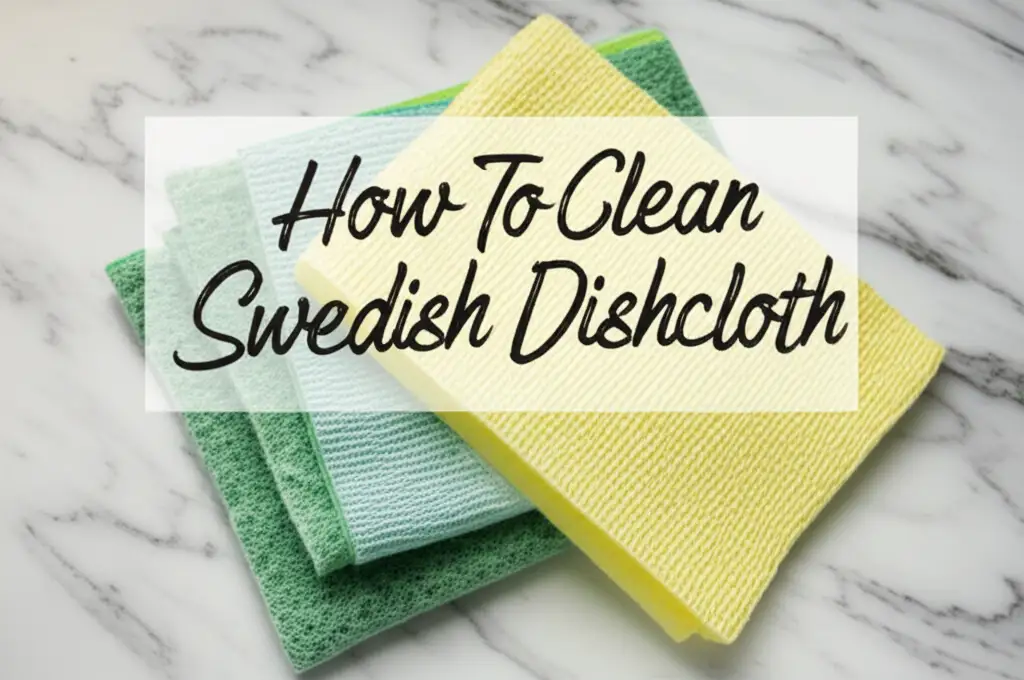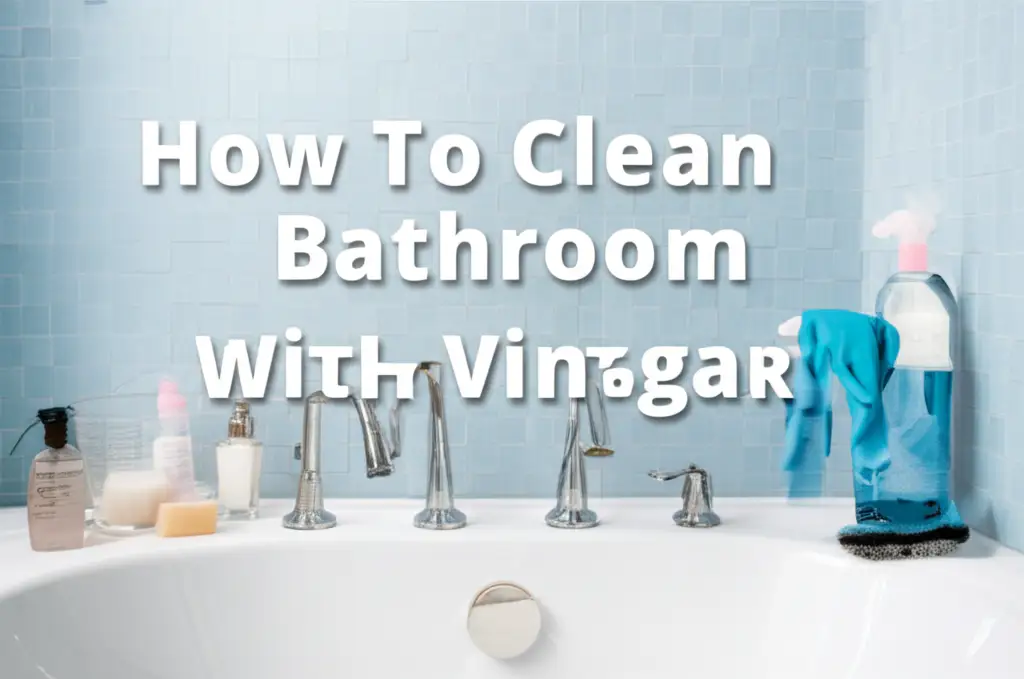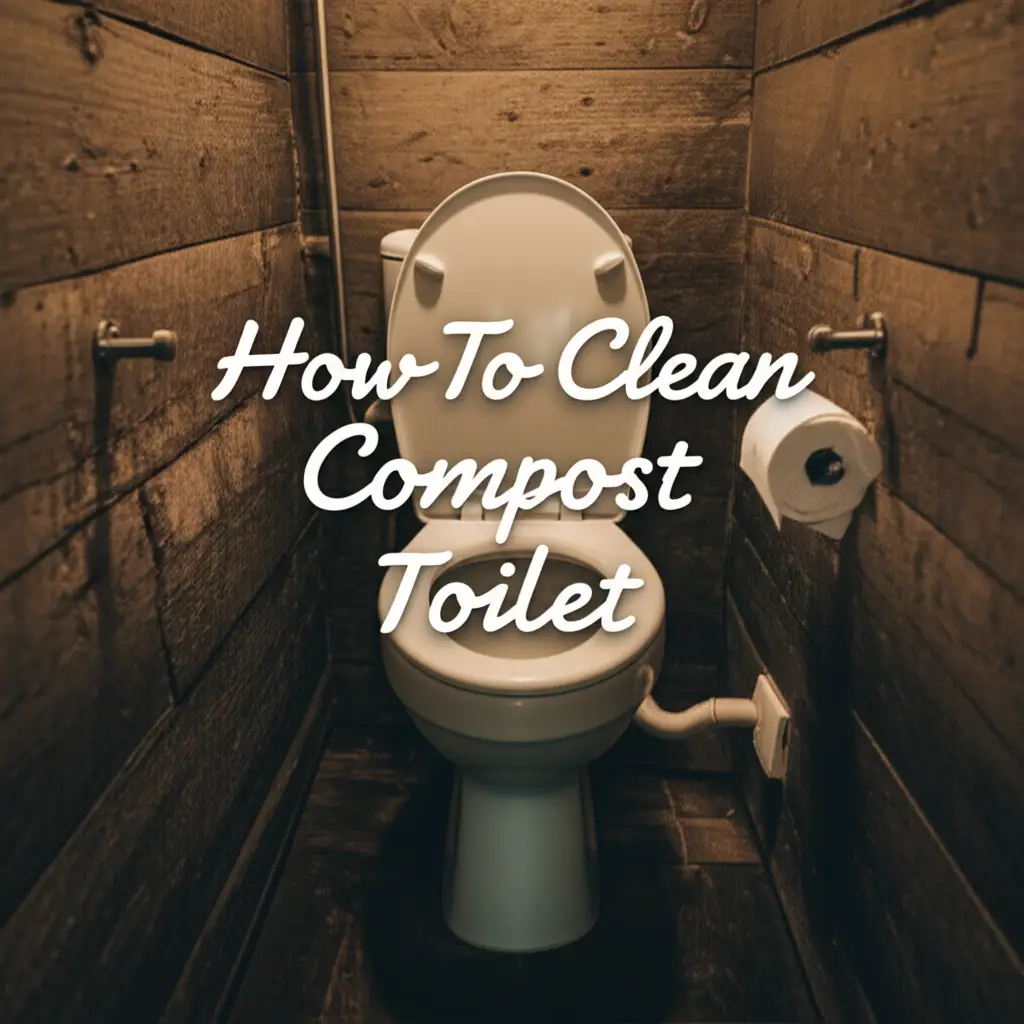· Home Cleaning · 18 min read
How To Clean Grease With Cornstarch

Unlock the Power of Cornstarch to Clean Grease
Grease spills can turn a simple cooking session into a cleanup nightmare. A slick, oily mess spreads quickly. It leaves behind stubborn stains and a sticky film. You might reach for harsh chemical cleaners. However, these products often come with strong fumes and environmental concerns.
What if a simple pantry staple held the key to a spotless kitchen? This article explores how to clean grease with cornstarch. This natural powder offers a surprisingly effective solution for tackling various grease challenges. We will cover why cornstarch works, how to use it step-by-step, and specific applications for different surfaces. Prepare to discover a new, eco-friendly way to keep your home pristine.
Takeaway:
- Cornstarch effectively absorbs liquid grease.
- Apply cornstarch generously to the greasy area.
- Allow time for the cornstarch to fully absorb the grease.
- Sweep or vacuum away the powdery residue.
- This method works on many surfaces, from fabrics to countertops.
Cornstarch cleans grease by absorbing oil molecules. It turns liquid grease into a powdery, easy-to-remove substance. You apply it to the greasy area, let it sit to absorb, then sweep or vacuum the residue away. This method works well on fabrics, carpets, and hard surfaces.
Why Cornstarch is Your Go-To Grease Buster
Many people know cornstarch as a kitchen thickener. It also excels as a powerful grease absorbent. This simple, natural powder has a unique molecular structure. It effectively soaks up oily substances. You can think of it like a tiny sponge for fats.
Cornstarch is a complex carbohydrate. Its fine texture and large surface area make it perfect for drawing oil away. When cornstarch meets liquid grease, its particles bond with the oil molecules. This process converts the liquid mess into a solid, powdery form. This makes cleanup incredibly easy.
Beyond its absorbent qualities, cornstarch offers several advantages over traditional cleaners. First, it is completely natural. It does not contain harsh chemicals. This makes it a safer choice for homes with children and pets. Second, cornstarch is readily available. You likely already have some in your pantry. Third, it is incredibly inexpensive. You can clean large grease spills without breaking your budget. This makes it an accessible solution for everyday messes.
Using cornstarch also supports eco-friendly cleaning practices. Chemical cleaners often release volatile organic compounds (VOCs). These can pollute indoor air and water systems. Cornstarch provides a biodegradable alternative. It breaks down naturally without harming the environment. I find it reassuring to use products that are both effective and responsible. This makes cornstarch a smart choice for any household looking to reduce its chemical footprint.
Preparing Your Surface for Cornstarch Grease Removal
Successful grease cleaning with cornstarch starts with proper surface preparation. This initial step helps the cornstarch work most efficiently. It also prevents the grease from spreading further. Taking a few moments to prepare ensures a cleaner outcome.
First, identify the type of surface you are dealing with. Different materials may require slightly different approaches. For example, a hard countertop responds differently than a fabric couch. Knowing your surface helps you decide how much cornstarch to apply. It also guides your removal method.
Always blot or scrape away any excess liquid grease. Do this gently with a paper towel or a dull knife. You want to remove as much surface grease as possible. This leaves less for the cornstarch to absorb. Pressing too hard can push grease deeper into fibers, so be careful.
Ensure the area is dry before applying cornstarch. Cornstarch absorbs oil, not water. A wet surface will dilute the cornstarch. It will reduce its effectiveness. If the spill is fresh, blotting should dry it sufficiently. For older, slightly damp stains, allow the area to air dry completely.
Soft Surfaces: Carpets, Upholstery, and Clothing
Grease stains on soft surfaces can feel daunting. However, cornstarch is very gentle. It can lift grease without damaging fibers. Blot any fresh grease with a clean cloth. Do not rub, as rubbing spreads the stain. Then, sprinkle cornstarch directly onto the stain. Ensure the stain is completely covered with a thick layer. This allows maximum absorption into the fabric. For clothing, remove the item before applying the cornstarch. You can then gently brush it off later.
Hard Surfaces: Countertops, Flooring, and Appliances
Hard surfaces are usually easier to clean. Grease often sits on top. Use a paper towel to wipe up any standing liquid grease. Then, generously sprinkle cornstarch over the greasy area. Make sure it forms a visible layer. The cornstarch will begin to absorb the grease immediately. On surfaces like your kitchen counter, it helps to clean grease from kitchen cabinets nearby. Cleaning grease from kitchen cabinets often follows stovetop or counter spills. Ensure the surface is dry before application. This method is surprisingly effective.
Step-by-Step Guide: Cleaning Grease Spills with Cornstarch
Cleaning a fresh grease spill with cornstarch is simple. It requires patience more than effort. Following these steps ensures the best results. You will turn a greasy problem into a simple dust-up.
First, act quickly. The sooner you treat a grease spill, the easier it is to remove. Fresh grease has not had time to set into the material. It remains on the surface, ready for absorption. Speed is a key factor in successful grease removal. I always keep cornstarch handy in my kitchen for this very reason.
Step 1: Blot Excess Grease. Start by carefully blotting up any standing liquid grease. Use paper towels or a clean, absorbent cloth. Press gently onto the spill. Avoid rubbing, as this can spread the grease and push it deeper into the surface fibers. Your goal is to remove as much visible grease as possible without smearing it. This initial blot helps the cornstarch work more efficiently.
Step 2: Apply Cornstarch Generously. Once the excess grease is blotted, sprinkle a thick layer of cornstarch directly over the entire greasy area. Ensure the stain is completely covered. You want a visible mound of cornstarch on top of the grease. Do not be shy with the amount. The cornstarch needs to make full contact with the grease for optimal absorption. For particularly large spills, I use a spoon to spread it evenly.
Step 3: Allow Absorption Time. This is a crucial step that requires patience. Let the cornstarch sit on the grease for at least 15-20 minutes. For larger or older stains, you might need to leave it for several hours, or even overnight. As it sits, the cornstarch absorbs the oil. You will notice the cornstarch clumps together or changes color as it soaks up the grease. The longer it sits, the more grease it can absorb.
Step 4: Remove the Cornstarch. Once the cornstarch has absorbed the grease, it will look like a clumped, yellowed powder. Carefully brush off the cornstarch into a dustpan. For carpets or upholstery, use a vacuum cleaner with a brush attachment. Ensure you remove all the powdery residue. This step lifts away the grease trapped within the cornstarch.
Step 5: Inspect and Repeat if Necessary. After the initial removal, inspect the area. Does a grease mark still remain? If so, repeat the entire process. Apply fresh cornstarch to the remaining stain. Let it sit again. You may need to repeat these steps several times for very stubborn or old stains. Each application will draw out more grease. This thorough process ensures the best possible cleaning.
For tough kitchen areas, such as how to clean grease from your air fryer, this method can be very helpful as a pre-treatment. Similarly, when dealing with general how to clean grease from kitchen cabinets, the cornstarch method can lift the initial sticky layer before a final wipe down. This systematic approach ensures effective grease removal.
Tackling Stubborn Grease Stains and Residue
Not all grease messes are fresh spills. Sometimes, you encounter stubborn, set-in stains or sticky residue. These require a bit more effort than a simple sprinkle and wipe. However, cornstarch still plays a vital role. It can help loosen and lift even older grease.
Old grease stains have often bonded more tightly with the surface. This makes them harder to remove. Heat can also bake grease onto surfaces, creating a tough film. While cornstarch works best on liquid grease, it can still assist. It works by slowly drawing out the embedded oil. You might need to combine it with other gentle cleaning agents or repeat the process multiple times.
For older stains, I often create a paste. Mix cornstarch with a small amount of water. You want a thick, spreadable consistency. This paste can sit on the stain for a longer period. It provides prolonged contact for absorption. The cornstarch still draws out the oil, but the moisture helps it penetrate slightly better into the hardened grease.
Grease on Fabric and Carpets
Grease stains on fabric or carpet can be persistent. For older stains, sprinkle a generous amount of cornstarch. Gently rub it into the stain with a soft brush or your fingers. Let it sit overnight if possible. The longer it stays, the more oil it absorbs. In the morning, vacuum the cornstarch away. If a shadow remains, you might need to follow up. A small amount of dish soap diluted in water can help. Gently blot the area with the soapy solution. Then blot with clean water and let it dry. This combined approach often lifts the most stubborn marks.
Grease on Kitchen Surfaces
Kitchen surfaces, like countertops and stovetops, often collect grease. These areas can develop a sticky film over time. For this, apply cornstarch generously over the greasy film. Let it sit for at least 30 minutes. The cornstarch will absorb the stickiness. Then, wipe away the powdery residue. The surface should feel much less greasy. You can then follow up with your usual cleaner. This pre-treatment makes the final cleaning much easier. It also helps with general how to clean grease off stainless steel appliances.
Grease on Pots and Pans
Baked-on grease on cookware is notoriously difficult. While cornstarch alone won’t strip away heavily burnt residues, it can help. For pans with a fresh layer of sticky grease, sprinkle cornstarch. Let it sit for a few hours. This absorbs the surface oil. Then, scrub with a brush and hot, soapy water. This makes the scrubbing less arduous. For truly stubborn, how to clean baked on grease from pans often requires more abrasive or chemical solutions. However, cornstarch reduces the initial mess. It acts as a good first step. If you are dealing with truly burnt-on areas, knowing how to clean burnt grease from bottom of frying pans involves different techniques, but cornstarch can reduce fresh accumulations.
Using Cornstarch for Specialized Grease Cleaning Tasks
Cornstarch’s grease-absorbing power extends beyond simple spills. It can be a versatile tool for various specialized cleaning tasks. I have discovered its utility in unexpected ways around the house. These applications can save time and effort.
Think about areas where grease accumulates subtly. This includes range hoods, air fryer components, and even your hands after cooking. Cornstarch can pre-treat these surfaces. It makes the actual cleaning process much more effective. Its fine texture allows it to get into small crevices. This means it lifts hidden grease.
These methods use cornstarch’s absorbent properties in unique ways. They help maintain cleanliness in areas prone to grease buildup. They also minimize the need for harsh scrubbing. This makes cleaning simpler and more pleasant. I find it satisfying to use one simple ingredient for so many tasks.
Degreasing Hands After Cooking
After handling greasy foods or working with oils, your hands can feel slick. Soap and water alone sometimes struggle to cut through the grease. Before washing, sprinkle a small amount of cornstarch onto your dry hands. Rub it between your palms and fingers. The cornstarch will absorb the excess oil. You will notice your hands feel less greasy almost instantly. Then, wash your hands with soap and water as usual. The soap will emulsify the remaining oil and cornstarch. Your hands will feel cleaner and less sticky.
Cleaning Stainless Steel Appliances
Stainless steel appliances attract fingerprints and grease smudges. Cornstarch can help here too. After wiping down your how to clean grease off stainless steel surfaces, sometimes a faint oily residue remains. To give them a streak-free shine, lightly dust the surface with cornstarch. Then, buff it off with a clean, dry microfiber cloth. The cornstarch absorbs any lingering oils. It leaves behind a sparkling, polished finish. This trick works well on refrigerators, dishwashers, and ovens.
Pre-treating Air Fryer Components
Air fryers are fantastic for cooking, but they can accumulate grease quickly. This grease can become baked on with repeated use. Before a deep clean, a cornstarch treatment can help. For your how to clean grease from air fryer basket or tray, sprinkle cornstarch on the greasy areas. Let it sit for a few hours. The cornstarch will soak up much of the liquid grease. This makes the subsequent scrubbing much easier. You will find that less scrubbing is needed to remove sticky residue.
Handling Kitchen Exhaust Fan Grease
Kitchen exhaust fans are magnets for grease. Over time, a thick, sticky layer builds up. This can reduce the fan’s efficiency. Before tackling the heavy cleaning, lightly dust the fan blades and grates with cornstarch. Let it sit for 30 minutes to an hour. The cornstarch will cling to and absorb some of the surface grease. This pre-treatment helps to loosen the grime. It makes wiping down the how to clean kitchen exhaust fan grease less challenging. You will find that less scrubbing is needed.
Cornstarch vs. Other Natural Grease Cleaners: A Comparison
When it comes to natural grease cleaning, cornstarch often gets compared to other common household items. Baking soda and salt are popular choices. Each has its strengths and best uses. Understanding these differences helps you choose the right tool for the job. I find it useful to know which ingredient performs best in specific scenarios.
Cornstarch stands out primarily for its exceptional absorption capacity. Its fine, powdery texture allows it to coat grease molecules effectively. It turns liquid grease into a solid, manageable substance. This makes it ideal for blotting up spills or lifting fresh oily stains. Its strength lies in this physical absorption. It doesn’t chemically break down grease. It simply soaks it up.
Baking soda, on the other hand, is a mild abrasive and a deodorizer. It has some absorbent qualities, but less than cornstarch for pure liquid grease. Baking soda excels at scrubbing away baked-on grime. It also neutralizes odors. You often see it used in pastes for scrubbing. It works well on surfaces that need a gentle scour. It’s fantastic for tackling soap scum in showers or as part of a solution for how to clean baked on grease from pans where scrubbing is involved.
Salt is another absorbent option. Its granular structure makes it good for small, fresh spills, especially on hard surfaces. The larger grains of salt can help lift fresh oil. However, its absorption power is generally less than cornstarch. Salt is also more abrasive. It might not be suitable for delicate surfaces. It’s often recommended for wine spills or as a quick blot for fresh oil on a counter.
So, when is cornstarch preferred?
- Liquid Grease Spills: Cornstarch is the champion for fresh, liquid grease spills on carpets, upholstery, or even hard floors. Its superior absorption quickly turns the liquid into a powder.
- Delicate Surfaces: Its non-abrasive nature makes it safer for materials like silk, suede, or painted surfaces, where scrubbing could cause damage.
- Pre-treatment: Cornstarch is excellent for drawing out surface grease before a deeper clean. This applies to appliances, fabrics, or kitchen surfaces.
Baking soda is better for:
- Scrubbing: When you need a gentle abrasive action to remove baked-on or sticky residues.
- Odor Neutralization: If the grease stain also carries an odor.
Salt is a quick fix for:
- Small, Fresh Spills: Especially on hard, non-delicate surfaces, where a quick sprinkle and wipe is needed.
In my experience, having all three natural degreasing agents on hand is best. They each serve a specific purpose. Cornstarch is my first choice for absorbing liquid grease. Baking soda tackles the more stubborn, caked-on grime. Salt is for very small, immediate blotting. Together, these eco-friendly cleaners offer a comprehensive solution for various household grease challenges.
Important Tips and Precautions for Using Cornstarch
Using cornstarch to clean grease is generally safe and effective. However, a few important tips and precautions ensure the best results. They also help keep your cleaning process safe. Knowing these details can prevent unexpected issues. I always follow these guidelines myself to ensure a smooth cleaning experience.
First, always remember that cornstarch is a fine powder. It can create dust when applied or swept away. If you have respiratory sensitivities, consider wearing a mask. This prevents inhaling the fine particles. Good ventilation in the area is also beneficial. Open a window or turn on a fan while cleaning.
It is crucial not to use cornstarch near or on hot grease. Cornstarch is flammable. If it comes into contact with very hot oil, it could ignite. Always let the grease cool down first. This precaution is vital for kitchen safety. Never try to put out a grease fire with cornstarch.
Before applying cornstarch to an entire stain, perform a patch test. Choose an inconspicuous area of the material or surface. Apply a small amount of cornstarch. Let it sit for a few minutes, then remove it. Check for any discoloration or adverse reactions. While cornstarch is usually safe, some very delicate or dyed fabrics might react unexpectedly. This step gives you peace of mind.
Proper disposal of greasy cornstarch is also important. The cornstarch absorbs the oil. This means the powder you sweep up is now saturated with grease. Do not pour this down your drain. The grease can still clog pipes over time. Instead, scoop the soiled cornstarch into a plastic bag. Seal it tightly. Then, dispose of it in the regular trash. This prevents plumbing issues, which can be costly to fix. For instance, knowing how to clean grease from drain pipes involves different methods entirely. Proper disposal prevents needing such interventions.
While cornstarch is amazing for liquid grease, it has limitations. It is less effective on heavily baked-on or very old, solidified grease. For these types of messes, you might need stronger methods. This could include specialized degreasers or abrasive cleaners. For instance, how to clean burnt grease from bottom of frying pans often requires dedicated scrubbing tools or chemical solutions. Cornstarch can pre-treat, but it won’t magically dissolve tough, old layers.
Finally, remember that cornstarch is a cleaning aid, not a disinfectant. While it removes grease, it does not kill germs. After using cornstarch, especially on kitchen surfaces, follow up with a regular cleaner or disinfectant. This ensures a truly clean and hygienic surface. Always prioritize both cleanliness and sanitation.
FAQ Section
Q1: Can cornstarch remove old grease stains?
Cornstarch is most effective on fresh grease spills. It can help with older stains, but it requires more patience. Apply a generous layer of cornstarch and let it sit for several hours or overnight. You may need to repeat the process multiple times. Each application helps draw out more of the embedded oil, slowly lifting the stain.
Q2: Is cornstarch safe for all surfaces?
Cornstarch is generally safe for most surfaces, including fabrics, carpets, wood, and countertops. It is non-abrasive. However, always perform a patch test on an inconspicuous area first. This checks for any potential discoloration or adverse reactions. It is a good practice, especially on delicate or darkly dyed materials.
Q3: How long should I leave cornstarch on grease?
For fresh grease spills, 15 to 20 minutes is often sufficient. For larger spills or older, more stubborn stains, leave the cornstarch on for several hours. Overnight application can be very effective for set-in grease. The longer it sits, the more time it has to absorb the oil effectively.
Q4: Can I use cornstarch for baked-on grease?
Cornstarch is less effective on heavily baked-on or carbonized grease. Its primary function is to absorb liquid oils. It can help loosen surface stickiness on baked-on grease as a pre-treatment. For stubborn baked-on grime, you will likely need stronger cleaning agents or abrasive scrubbing.
Q5: What’s the difference between cornstarch and baking soda for grease?
Cornstarch excels at absorbing liquid grease due to its fine texture. It turns liquid oil into a powdery, easily removable substance. Baking soda is a mild abrasive and a deodorizer. It works better for scrubbing away sticky or caked-on residues. It also helps neutralize odors. Both are natural, but they serve different roles in grease cleaning.
Conclusion
Grease messes are an inevitable part of cooking and daily life. You no longer need to fear them. Knowing how to clean grease with cornstarch equips you with a simple, powerful solution. This humble kitchen ingredient stands out for its natural effectiveness. It offers a gentle yet mighty approach to tackling oily spills and sticky residues.
We have explored the science behind cornstarch’s grease-absorbing power. We have also walked through the step-by-step process for various surfaces. From fresh spills on carpets to lingering stickiness on kitchen cabinets, cornstarch proves its versatility. It is a safe, affordable, and eco-friendly alternative to many harsh chemical cleaners. Embracing cornstarch means choosing a cleaner home and a healthier environment.
I encourage you to try this method for your next grease challenge. You will be amazed by the results. Keep a box of cornstarch handy in your cleaning arsenal. It transforms daunting grease problems into easy cleanups. Go forth and conquer those greasy messes with confidence! Your home will thank you.
- how to clean grease
- cornstarch cleaning
- natural degreaser
- kitchen grease removal
- eco-friendly cleaning




